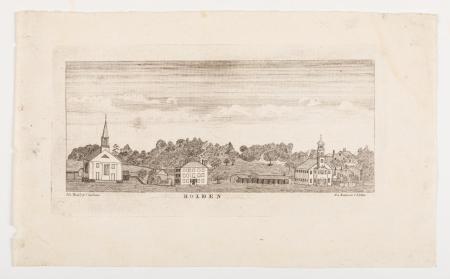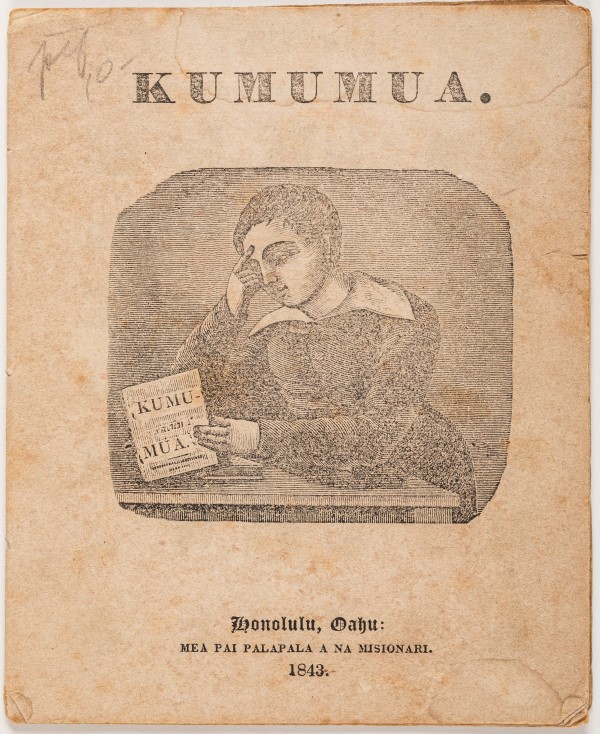
Holden, 1838.
Catalog record
Early Printing in Hawaiian | People in the Collection
History of the Hawaiian Collection at AAS
Worcester, Massachusetts, may not be the most obvious site for a hotbed of Hawaiiana, but that is where the American Antiquarian Society has one of the strongest collections of early Hawaiian printing outside of the islands. This is in part because of strong New England connections with many of early U.S. missionaries, sailors, and merchants who went to Hawaiʻi. In fact, one of the first engravings done by a native Hawaiian in the Hawaiian islands is of a town in Worcester County. Missionary Edward Bailey sketched from memory the main street of his hometown of Holden, Massachusetts, which was then engraved in copper by Kapeau.

Catalog record
The collection of Hawaiian materials accessible to all at AAS was primarily built in the first half of the twentieth century with significant additions in the early twenty-first century. Gifts from descendants of Massachusetts residents who maintained connection with the islands and exchanges historical societies on the islands have largely built the collections. A substantial addition was the purchase of the library of Hiram Bingham, one of the first missionaries on the islands. Donations from the James Hunnewell family, descendants of a sailor on the first missionary vessel that arrived in Hawaiʻi in 1820, continue to enrich AAS's collections.
* In this resource, the ʻokina and accented vowels are not used when quoting historical spelling.
This project has been made possible by a grant from the Pine Tree Foundation.
Additional Resources

Catalog record
In the last decade, AAS’s Hawaiian collections have been featured in multiple press stories on Boston-area television and radio, in newspapers like Honolulu Civil Beat, and in AAS-produced YouTube videos. In 2019 AAS hosted a performance and discussion of “My Name is ʻŌpūkahaʻia,” about the first missionaries to Hawai’i.
The AAS digital collection is only a small part of a wider web of Hawaiian collections available online.
- The Office of Hawaiian Affairs’ (OHA’s) Papakilo Database is a comprehensive database of databases consisting of varied collections of data pertaining to historically and culturally significant places, events, and documents in Hawai'i’s history.
- See David W. Forbes, Hawaiian National Bibliography, 1780-1900 (Honolulu, 2000) for bibliographical information on Hawaiian books.
The work is full-text searchable online in the Papakilo Database. - For more on Lahaina or Lahainaluna Seminary and engraving, see David W. Forbes, Engraved at Lahainaluna (Honolulu, 2012) or the Lahaina Restoration Foundation.
- For a detailed history of Hawaiian journalism, see a brief chronicle of the newspapers and newspeople by the University of Hawaiʻi at Mānoa.
- For over 200 letters written by 33 ali'i digitized, transcribed, translated, and annotated, see Ali'i Letters by the Hawaiian Mission Houses and the Awaiaulu Foundations.
- Hawaiian Newspapers Collection on Papakilo
This is a digital collection of historic Hawaiian Newspapers, ranging from 1834 to 1980. - Ulukau
Ulukau, the Hawaiian Electronic Library, makes resources available for the use, teaching, and revitalization of the Hawaiian language and for a broader and deeper understanding of Hawaiʻi.
Vocabulary
Deeper understanding of both current meaning and historical usage of Hawaiian words can be developed using the Ulukau dictionaries (https://wehewehe.org/gsdl2.85/cgi-bin/hdict?l=en).
Some Hawaiian words featured in this resource are:
- Aliʻi (upper class leaders)
- Hale pili (grass house)
- Moʻolelo Hawaiʻi (Hawaiian history or genealogy)
- Nupepa (newspapers)
- ʻOkina (ʻ) (consonant representing a glottal stop)
- ʻŌlelo Hawaiʻi (Hawaiian language)
- Papapala (learning, reading, writing, printing, engraving)
Sources Consulted for this Resource
- Adler, Jacob; Kamins, Robert M. The Fantastic Life of Walter Murray Gibson: Hawaii's Minister of Everything. Honolulu: University of Hawaii Press, (2019) [1986].
ISBN 978-0-8248-8366-9. OCLC 1126516674. - Andrews, Lorrin. "A dictionary of the Hawaiian language, to which is appended an English-Hawaiian vocabulary and a chronological table of remarkable events." Honolulu: H.M. Whitney, 1865. p. 559. Internet Archive.
- "Edward Bailey." The Church Historian's Press. Accessed June 13, 2025.
- "H. M. Whitney: Founder of this paper is dead." The Hawaiian Gazette (Honolulu, Hawaiʻi), August 19, 1904. pp. 1, 4.
- "Joseph U. Kawainui." Hawaiian Gazette (Honolulu, Hawaiʻi), October 25, 1895.
- "Joseph U. Kawainui announces intent to publish a new paper run by Hawaiians, 1877." Nupepa. Last modified August 8, 2017.
- "Lahainaluna School student roster, where it all started, 1858." Nupepa. Last modified May 30, 2014.
- "Land by Entity Index Card "KEPOHONI, LUTERA." February 15, 1847. Digital Archives of Hawaiʻi.
- "New Hampshire, Birth Records, Early to 1900", Entry for Josiah Fuller and Robert Fuller, 1 May 1814. FamilySearch. Retrieved July 7, 2025.
- "Old Solon Is Dead." Hawaii Tribune-Herald (Hilo, Hawaiʻi), April 13, 1918. newspapers.com (118724459).
- "On the Passing of Simona Petero Kalama, 1875." Bishop Museum Blog. Accessed June 9, 2025.
- "Richard Armstrong". State archives. State of Hawaii. Archived from the original on July 30, 2010. Retrieved July 7, 2025.
- "Short biography of the great Joseph Mokuohai Poepoe, 1912." Nupepa. Last modified March 2, 2016.
- Spurrier, Joseph H. Sandwich Island Saints: Early Mormon Converts in the Hawaiian Islands. 1989. The King v. Aiko, 1 Haw. 144. (1854).
- Thurston, Lucy G. Life and Times of Mrs. Lucy G. Thurston, wife of Rev. Asa Thurston. Ann Arbor: S.C. Andrews, 1882. Internet Archive.